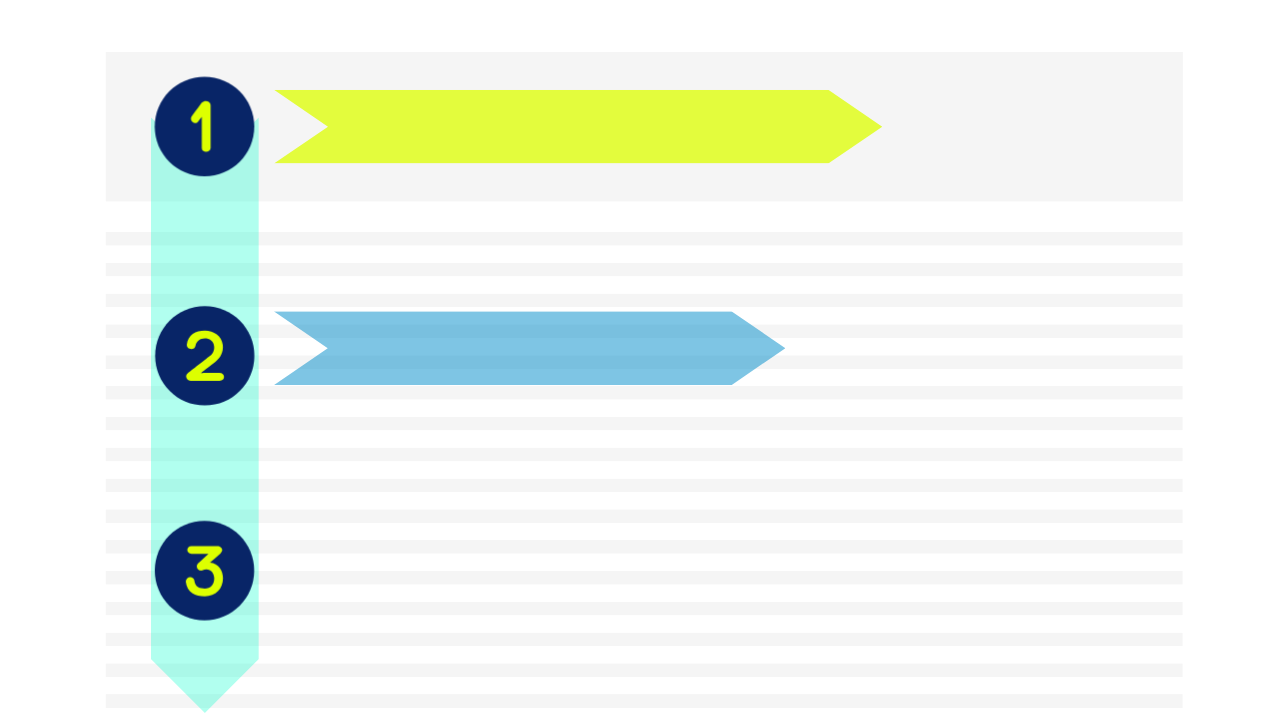 Job Search
Job Search
How The F-Shaped Reading Pattern Can Transform Your Resume
- by Holly Burton
Ever feel like people barely read the resumes you spend hours carefully customizing, spell checking, and adjusting to pixel perfection?
You’re right!
Nobody’s Reading Your Whole Resume
According to a 2018 eye-tracking study by the career site The Ladders, recruiters spend an average of only 7.4 seconds skimming through your resume to decide if it’s headed for the trashcan or merits a closer look.
As shocking as this stat is – that resume took hours to put together! – it’s actually the way that most people engage with written content in general. We, the denizens of Al Gore’s Internet, are prolific skimmers and scrollers, rarely pausing our voracious search for new content long enough to, you know, actually read what we find. Most of the information put in front of us doesn’t actually get read – just like it is for recruiters.
So what the heck are you supposed to do with this information? Give up? Slip into depression? Sell your house and go live in the woods so you don’t need a job or a paycheque ever again?
Nah. You just need to learn to take advantage of the small bits of attention your resume does get so you can grab recruiters’ attention and get an interview scheduled.
And luckily for you, there’s a nifty little trick from the world of user experience research that will help you make sure recruiters and hiring managers see you for the ultra-hirable gem you are.
The F-Shaped Reading Pattern
The F-Shaped reading pattern comes from research done in 2006 by UX Researchers Nielsen Norman Group about how folks engage with written content on digital platforms. They tracked people’s eye movement as they read and found that – surprise! – people tend to read in the shape of an F.
So what does that mean?
It means that people’s reading tends to follow this pattern:
- They focus heavily on the first few lines of text, reading all the way across (like the top of the F).
- Then, they move slightly down the page, and read most of the way along another line or two (like the middle bar of the F)
- And finally, They skim the down the left-hand side of the page, reading the first word or two in each paragraph, looking for something interesting to grab their attention (like the long vertical section of the F)
In practice, it looks like this:

How to Use the F-Shaped Reading Pattern in Your Resume
Since we know that most people read using this pattern, we can adapt to it.
We can change the way we present our resume and make sure the things that make us sound the most desirable to hiring managers are right there in that prime, F-shaped real estate.
There are three key modifications to make to your resume to make sure the important stuff gets seen:
#1 - The Top of Your Resume is the Most Important Real Estate
Where does the F-shaped reading pattern tell us people actually read in detail? The top of the page! Your reader has more interest, less attention fatigue at the start of your document than anywhere else. So we need to make sure we use this space well.
That means the first 2-3 lines of your resume that go all the way across the page deserve a lot of care and attention. These few sentences need to be concise, and all killer, no filler (ie: made up of only and exactly the information that will get you hired!)
Let’s do an example to illustrate. Let’s imagine you were hiring a new sales person. Which of these two options would get you more excited to continue reading?
Option 1:
Enterprise sales executive with 12 years of experience managing a $3M book of business. Exceeded quota by over 20%, three years in a row. An expert in consultative selling and moving complex deals through organizational bureaucracy efficiently to generate closed deals.
OR
Option 2:
Experienced sales person looking to work for an exciting, innovative company in the B2B SAAS space. Friendly and persistent, I’m an expert at developing long-lasting relationships, mentoring colleagues, and working as a team player.
Option 1 is obviously more compelling, right? That’s because it’s results-focused, full of quantifiable proof of my skills and competencies, and aimed directly at the things hiring managers most want to hire for.
Option 2 takes up the same amount of valuable real estate, but doesn’t quite get the job done. Everything listed here is nice enough – who wouldn’t want to hire a team player? – but imagine if this was the only thing the hiring manager absorbed in their 7.4 second skim. Would they hire a sales person who was a great team player without knowing that they could…you know, actually sell? Absolutely not.
So make sure the top of your resume contains the ‘must-have’ information about your specific skills and your quantifiable results, and leave the ‘nice to haves’ – personal qualities, education, volunteer opportunities – for the parts of your resume more likely to be skimmed.
When in doubt, remember: These sentences like they are the only thing a recruiter might read about you – because they just might be!
Want A New Resume Without Pulling Your Hair Out?
Let’s make your resume writing way more effective, a heck of a lot less stressful, and not at all threatening to your follicular health!
#2 - Put The Important Stuff at the Start of the Sentence
Just like we want to prioritize putting the eye-catching skills at the top of our resume to take advantage of the long horizontal part of the F, we want to make sure we have some yummy bait for the skimming that happens all the way along the left hand side.
Let’s imagine you’re reading the bullet points under someone’s latest work experience on a resume and you see this one:
- Modified the customer onboarding system over 6 months, switching software providers and re-designing automated flows, resulting in a 20% increase in customer retention
What’s the most interesting part of that bullet point? The 20% increase in customer retention! Wowza! What a great thing to brag about!
The problem is, it’s hidden all the way over on the right side of the page in reading pattern Siberia, never to be noticed by a hiring manager! They’ll hardly even shift their little eyeballs along that sentence when it starts with the snoozefest of “Modified the customer onboarding system….”
So we need to start the bullet point with something more interesting. The easiest way to do this is what I like to call “results-first bullet points”.
Basically, just take those amazing 20% customer retention results, and reconfigure the sentence so it’s at the beginning:
- Increased customer retention by 20% in 6 months by modifying the customer onboarding system, switching software providers and re-designing automated flows
See how much more readable and impressive this version is? That’s the magic of adapting to the F-Shaped reading pattern!
#3 - Headings Are Your Best Friends
So at this point you might be asking yourself what is the point of producing an entire two-page resume if the only part recruiters read is the first few sentences and a couple keywords along the left margin.
The good news is: I have a way to make them read more of your resume!
Other UX research on the ways that people read tells us that headings tend to ‘refresh’ people’s attention. Headings cause folks to interrupt their left-hand-side skim and read across the page again, almost creating a new F-shaped reading pattern under the heading.
Luckily for you, your resume already contains several ‘natural’ headings in the form of your successive work experiences. Every time you switch roles or companies, your resume has a new little heading section with the company name, your title or position, and your dates of employment. That means you get an instant attention refresh!
Right under a heading is the second most valuable real estate on your resume because, just like at the top of your document, people will tend to scan over to the right and start reading in full sentences again for a line or two. Leverage this in the same way as you did the start of your resume: Make sure the first two bullet points under each job on your resume are punchy, concise, and filled with must-have skills.
One of the most common mistakes I see in resumes is not using those first few bullet points for your most impressive accomplishments. I don’t have enough fingers to count the number of times I’ve seen eye-popping achievements buried 15 bullet points deep where no one will see them. Give those the VIP treatment, right underneath the header so your future manager can see how great you are!
In Conclusion: Up & To The Left
Building a readable resume in today’s information overload attention economy is no small feat, but it’s definitely worth it. All you need to do is re-orient your resume so it lines up with how recruiters and hiring managers are actually reading it.
Put all of your shiniest, most attractive skills and accomplishment “up and to the left” on your resume:
- In the first few lines at the top of the page;
- In the first few words on the left; and
- Under every heading
If you can do those three things, you’ll be able to save your resume from its default 7.4-seconds-and-trash-can fate, and earn yourself a coveted interview where you can knock their socks off! Woo hoo.
Give it a try and let me know how it goes!
(or book a spot in my calendar for some resume consulting and I’ll help you get your resume in tip-top shape!)

